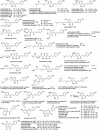Angelica keiskei, an emerging medicinal herb with various bioactive constituents and biological activities
- PMID: 28439780
- PMCID: PMC7090720
- DOI: 10.1007/s12272-017-0892-3
Angelica keiskei, an emerging medicinal herb with various bioactive constituents and biological activities
Abstract
Angelica keiskei (Miq.) Koidz. (Umbelliferae) has traditionally been used to treat dysuria, dyschezia, and dysgalactia as well as to restore vitality. Recently, the aerial parts of A. keiskei have been consumed as a health food. Various flavonoids, coumarins, phenolics, acetylenes, sesquiterpene, diterpene, and triterpenes were identified as the constituents of A. keiskei. The crude extracts and pure constituents were proven to inhibit tumor growth and ameliorate inflammation, obesity, diabetics, hypertension, and ulcer. The extract also showed anti-thrombotic, anti-oxidative, anti-hyperlipidemic, anti-viral, and anti-bacterial activities. This valuable herb needs to be further studied and developed not only to treat these human diseases but also to improve human health. Currently A. keiskei is commercialized as a health food and additives in health drinks. This article presents a comprehensive review of A. keiskei and its potential place in the improvement of human health.
Keywords: Angelica keiskei; Biological activity; Chemical constituent; Umbelliferae.
Conflict of interest statement
The co-authors have declared no conflict of interest.
Figures
Similar articles
-
Chemical constituents and bioactivities of plants of chloranthaceae.Chem Biodivers. 2008 Feb;5(2):219-38. doi: 10.1002/cbdv.200890020. Chem Biodivers. 2008. PMID: 18293432 Review. No abstract available.
-
Chemical Constituents of Plants from the Genus Eupatorium (1904-2014).Chem Biodivers. 2015 Oct;12(10):1481-515. doi: 10.1002/cbdv.201400227. Chem Biodivers. 2015. PMID: 26460556 Review.
-
Possible antithrombotic effects of Angelica keiskei (Ashitaba).Pharmazie. 2018 Jun 1;73(6):315-317. doi: 10.1691/ph.2018.8370. Pharmazie. 2018. PMID: 29880082 Review.
-
Inhibition of airway inflammation by the roots of Angelica decursiva and its constituent, columbianadin.J Ethnopharmacol. 2014 Sep 11;155(2):1353-61. doi: 10.1016/j.jep.2014.07.033. Epub 2014 Jul 25. J Ethnopharmacol. 2014. PMID: 25068578
-
Nephroprotective Activity of Angelica keiskei (Miq). Koidz. on Cisplatin-Induced Rats: Reducing Serum Creatinine, Urea Nitrogen, KIM-1, and Suppressing NF-kappaB p65 and COX-2.Drug Des Devel Ther. 2024 Oct 24;18:4707-4721. doi: 10.2147/DDDT.S481479. eCollection 2024. Drug Des Devel Ther. 2024. PMID: 39469724 Free PMC article.
Cited by
-
A Comparative Study of Binding Interactions between Proteins and Flavonoids in Angelica Keiskei: Stability, α-Glucosidase Inhibition and Interaction Mechanisms.Int J Mol Sci. 2023 Apr 1;24(7):6582. doi: 10.3390/ijms24076582. Int J Mol Sci. 2023. PMID: 37047555 Free PMC article.
-
Widely targeted metabolomics analysis reveals differences in volatile metabolites among four Angelica species.Nat Prod Bioprospect. 2025 Jan 2;15(1):2. doi: 10.1007/s13659-024-00485-5. Nat Prod Bioprospect. 2025. PMID: 39743660 Free PMC article.
-
An extract from the frass of swallowtail butterfly (Papilio machaon) larvae inhibits HCT116 colon cancer cell proliferation but not other cancer cell types.BMC Genomics. 2023 Dec 4;24(1):735. doi: 10.1186/s12864-023-09841-0. BMC Genomics. 2023. PMID: 38049715 Free PMC article.
-
Nutraceuticals and the Network of Obesity Modulators.Nutrients. 2022 Dec 1;14(23):5099. doi: 10.3390/nu14235099. Nutrients. 2022. PMID: 36501129 Free PMC article. Review.
-
Role of medicinal plants in inhibiting SARS-CoV-2 and in the management of post-COVID-19 complications.Phytomedicine. 2022 Apr;98:153930. doi: 10.1016/j.phymed.2022.153930. Epub 2022 Jan 5. Phytomedicine. 2022. PMID: 35114450 Free PMC article.
References
-
- Akihisa T, Tokuda H, Ukiya M, Iizuka M, Schneider S, Ogasawara K, Mukainaka T, Iwatsuki K, Suzuki T, Nishino H. Chalcones, coumarins, and flavanones from the exudate of Angelica keiskei and their chemopreventive effects. Cancer Lett. 2003;201:133–137. doi: 10.1016/S0304-3835(03)00466-X. - DOI - PubMed
-
- Akihisa T, Yasukawa T, Ukiya M, Hasegawa D (2007) Anti-inflammatory agents containing natural products from Angelica keiskei. (Nihon University, Japan). Application: JP
-
- Aoki N, Ohta S. Ashitabaol A, a new antioxidative sesquiterpenoid from seeds of Angelica keiskei. Tetrahedron Lett. 2010;51:3449–3450. doi: 10.1016/j.tetlet.2010.04.122. - DOI
Publication types
MeSH terms
Substances
LinkOut - more resources
Full Text Sources
Other Literature Sources
Molecular Biology Databases


